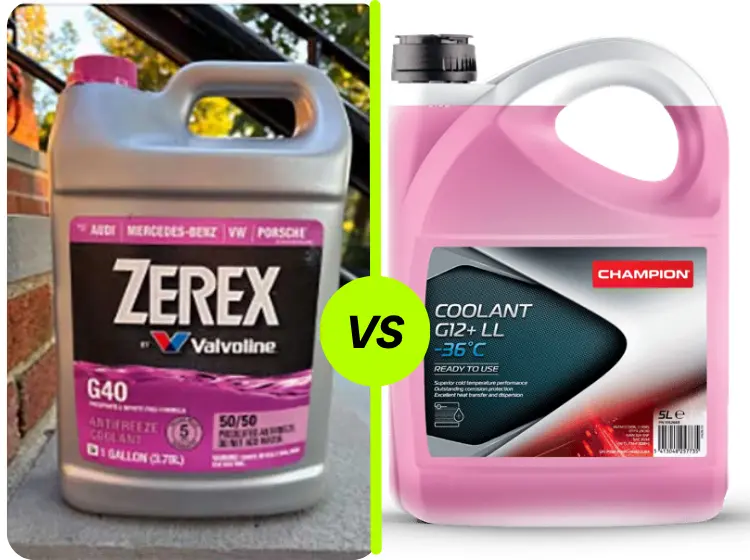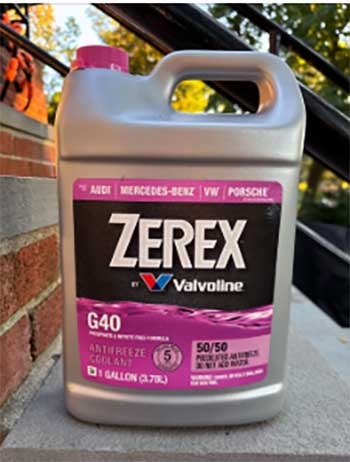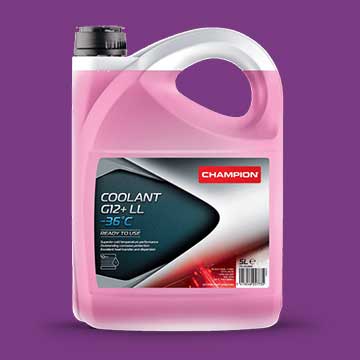As a car enthusiast who’s spent countless hours tinkering under the hood, I know picking the right coolant is critical for keeping your engine happy. Zerex G40 and G12 are two popular options, especially for European vehicles, but choosing between them can feel like navigating a maze. In this article, I’ll break down their differences, weigh their pros and cons, and share my insights to help you decide which coolant is best for your ride.
Let’s get under the hood and figure out what makes these coolants tick, so you can keep your engine running smoothly.

Comparison Table: Zerex G40 vs. G12 Coolant
| Feature | Zerex G40 | G12 |
| Type | Si-OAT (Silicate-Organic Acid Technology) | OAT (Organic Acid Technology) |
| Base Compound | Ethylene Glycol | Ethylene Glycol |
| Color | Pink/Violet | Pink/Red |
| Service Life | Up to 5 years or 150,000 miles | 2-3 years or 30,000-60,000 miles |
| Corrosion Protection | Excellent (silicates + organic acids) | Good (organic acids only) |
| Temperature Range | -34°F to 265°F (50/50 mix) | -58°F to 245°F (50/50 mix) |
| Compatibility | Newer models, backward compatible | Older models, limited compatibility |
| Price | Higher ($20-$35/gallon) | Lower ($15-$25/gallon) |
| OEM Approvals | VW TL 774-G, Porsche, BMW, Mercedes | VW TL 774-D/F, Audi, older VW models |
| Mixing with Other Coolants | Not recommended | Not recommended |
Why Coolant Matters to Me (and Should to You)
I’ve learned the hard way that coolant isn’t just colored liquid you pour into your radiator. It’s the lifeblood of your engine’s cooling system, preventing overheating, freezing, and corrosion. One time, I skimped on coolant for my old VW Golf, and a corroded water pump taught me a $500 lesson.
Whether you drive a sleek Porsche or a trusty Audi, choosing the right coolant—like Zerex G40 or G12—can save you from costly repairs. Both are designed for European cars, but their differences in performance, longevity, and compatibility make this choice critical. Let’s break it down.
Understanding Zerex G40: My Take on Its Features
Zerex G40 is like the high-tech cousin in the coolant family. It uses Silicate-Organic Acid Technology (Si-OAT), which blends silicates and organic acids for top-notch protection. I’ve used it in my 2015 BMW 3 Series, and it’s been a game-changer. The silicates form a protective film on metal surfaces, shielding your radiator and water pump from rust and corrosion. The organic acids, meanwhile, tackle long-term corrosion, making G40 a long-life coolant—up to five years or 150,000 miles.

What I love about G40 is its versatility. It’s approved for a wide range of modern European vehicles, including VW, Audi, Porsche, BMW, and Mercedes-Benz (VW TL 774-G spec).
It’s also backward compatible, meaning it can work in older models that originally used G12 or similar coolants, though I always double-check my owner’s manual.
Its temperature range is solid: -34°F to 265°F in a 50/50 mix with distilled water, which handles most climates I’ve driven through, from snowy winters to scorching summers.
Price-wise, G40 isn’t cheap—expect to pay $20-$35 per gallon. But for me, the peace of mind and longer service intervals make it worth the splurge.
Plus, it’s made by Valvoline, a brand I trust after years of using their products without a hitch. One thing to note: G40’s pink or violet color helps distinguish it, but don’t mix it with other coolants. I learned that mixing can lead to gelling, which clogs your system faster than a bad traffic jam.
Pros and Cons of Zerex G40
Pros
- Long Service Life: Lasts up to five years or 150,000 miles, meaning fewer trips to the shop.
- Superior Protection: Silicates and organic acids team up for excellent rust and corrosion defense, especially for aluminum and mixed-metal engines.
- Wide Compatibility: Works with modern European cars and many older models, making it versatile.
- High Heat Tolerance: Handles temperatures up to 265°F, perfect for hot climates or spirited driving.
- OEM Approved: Meets stringent specs for VW, Porsche, BMW, and Mercedes, so you know it’s legit.
Cons
- Higher Cost: At $20-$35 per gallon, it’s pricier than G12.
- Mixing Issues: Not compatible with non-Si-OAT coolants; mixing can cause gelling or reduced performance.
- Availability: Not always stocked at every auto parts store, especially in smaller towns.
Exploring G12: My Experience with the Classic Choice
G12, on the other hand, feels like an old friend. I used it in my 2002 VW Jetta, and it got the job done for years. It’s an Organic Acid Technology (OAT) coolant, relying solely on organic acids for corrosion protection. Unlike G40, it doesn’t use silicates, which can be a double-edged sword. It’s gentler on some gaskets but less proactive against rust since its protection kicks in only when corrosion starts. This reactive approach means you’ll need to change it more often—every 2-3 years or 30,000-60,000 miles.

G12 is tailored for older European vehicles, especially VW and Audi models from the late ‘90s to early 2000s (VW TL 774-D/F spec).
Its temperature range is impressive for cold climates, protecting down to -58°F, though it caps at 245°F on the high end.
This makes it a solid pick if you live somewhere with harsh winters, like the Midwest or Canada. At $15-$25 per gallon, it’s more budget-friendly than G40, which was a relief when I was a broke college kid working on my Jetta.
One quirk I noticed with G12 is its pink or red color, which can look similar to other coolants, so I always double-checked the label to avoid mix-ups.
It’s not as versatile or fully compatible with newer models, and finding it can be tricky since VW has phased it out in favor of G12++ or G13. If your car’s manual calls for G12, stick with it to avoid warranty issues, but be prepared for more frequent maintenance.
Pros and Cons of G12
Pros
- Affordable: At $15-$25 per gallon, it’s easier on the wallet than G40.
- Excellent Cold Protection: Handles temperatures down to -58°F, ideal for freezing climates.
- Proven for Older Models: Perfect for VW, Audi, and other European cars from the ‘90s and early 2000s.
- Widely Recognized: Long history of use in European vehicles, so it’s a trusted choice.
Cons
- Shorter Service Life: Needs changing every 2-3 years or 30,000-60,000 miles.
- Reactive Protection: Only fights corrosion after it starts, less effective than G40’s proactive approach.
- Limited Compatibility: Not ideal for newer models or mixed-metal engines.
- Harder to Find: Discontinued by VW, so availability can be spotty.
Breaking Down the Chemistry: What Makes Them Different?
As someone who’s curious about what goes into my car, I find the chemistry behind G40 and G12 fascinating. Both use ethylene glycol as their base, which is standard for preventing freezing and boiling. The real difference lies in their additive packages. G40’s Si-OAT formula combines silicates and organic acids, creating a protective barrier that’s like armor for your engine’s metal parts. This makes it ideal for modern engines with aluminum and mixed-metal components, which are common in newer BMWs or Porsches.
G12, being an OAT coolant, skips silicates and relies on organic acids alone. This was a big deal in the ‘90s when VW wanted to avoid silicate buildup in older systems. However, I’ve read that G12’s protection is more reactive, meaning it waits for corrosion to start before kicking in. In my Jetta, this wasn’t a huge issue, but in a high-performance car or one with aluminum parts, G40’s proactive approach feels safer. Mixing them? Bad idea. I’ve seen forums where folks mixed G40 and G12, only to end up with a sludgy mess that clogged their radiators.
Performance in Real-World Conditions
I’ve driven in all sorts of conditions, from blistering Texas summers to icy Colorado winters, and coolant performance matters. G40 shines in high-heat scenarios, like when I pushed my BMW hard on a road trip through the desert. Its 265°F boiling point (50/50 mix) kept the engine cool even when the outside temp hit 100°F. G12, however, was my go-to for my Jetta in cold climates. Its -58°F freeze protection saved me during a brutal Minnesota winter when temps dipped below zero.
One thing I’ve noticed is G40’s longevity. I didn’t have to think about flushing it for nearly five years, which is a blessing when you’re busy. G12, though, had me checking the calendar every couple of years. If you’re like me and hate frequent maintenance, G40’s extended life is a big win. But if you’re in a cold region and your car’s manual specifies G12, it’s a reliable, cost-effective choice.
Compatibility: Will It Work in My Car?
Choosing the right coolant often comes down to what your car’s manual says. I always pull out my owner’s manual (or Google it if it’s buried in my glovebox) to check the specs. G40 is a champ for newer European cars—think post-2008 VW, Audi, Porsche, BMW, or Mercedes. It’s also backward compatible with older models that used G12 or G12++, which is handy if you own a mix of old and new vehicles. I used G40 in my buddy’s 2005 Audi A4 after confirming it met VW TL 774-G, and it worked like a charm.
G12, however, is pickier. It’s designed for older VW and Audi models (1996-2002) and doesn’t play well with newer systems that require G12++ or G13. If your car’s cooling system has aluminum or magnesium components, G12 is a solid match, but don’t expect it to keep up with the demands of a modern high-performance engine. I’ve seen folks on forums like VW Vortex stress about using G40 in a G12 system. My take? If you’re topping off, a small amount of G40 in a G12 system probably won’t hurt, but for a full flush, stick to what your manual recommends to avoid headaches.
Cost and Availability: My Wallet’s Perspective
I’m no stranger to budget constraints, so cost is always on my mind. G12 is the cheaper option, typically $15-$25 per gallon, which was a lifesaver when I was maintaining my Jetta on a tight budget. You can still find G12 at some auto parts stores or online, though it’s getting rarer since VW moved to newer formulas like G12evo. G40, at $20-$35 per gallon, stings a bit more, but I justify it with the longer service life and better protection. I’ve found G40 at places like NAPA or O’Reilly, but smaller stores might only carry universal coolants, which I avoid like the plague.
One tip: always buy concentrate and mix it 50/50 with distilled water. Premixed coolants are convenient but cost more and take up space in my garage. Plus, mixing it myself lets me control the ratio for my climate—60/40 for colder winters, for example. If you’re hunting for either coolant, check online retailers like FCP Euro or AutoHausAZ for better deals than your local dealer, where prices can be steep.
My Real-World Mishaps and Lessons Learned
I’ll admit, I’ve made coolant mistakes. Once, I topped off my Jetta with a generic “universal” coolant because I was in a rush. Big mistake. Within months, I noticed sludge in the reservoir, and my mechanic wasn’t thrilled. That experience taught me to stick to OEM-spec coolants like G12 or G40. Another time, I used G40 in a friend’s older VW without flushing the system first. The mix of old G12 and new G40 caused a slight gel, and we had to flush the whole system. Lesson learned: always flush before switching coolants, and never assume “close enough” is good enough.
Forums like VW Vortex and BobIsTheOilGuy have been my go-to for real-world advice. Users there often recommend G40 for its versatility and longevity, especially for newer VWs or Porsches. Some old-school folks swear by G12 for their classic Audis, but they admit it’s harder to find. My takeaway? Do your homework, check your manual, and don’t mix coolants unless you want a science experiment in your radiator.
Making the Choice: G40 or G12 for You?
So, which coolant should you pick? If your car is a newer European model (post-2008) or has a mix of aluminum and other metals, I’d lean toward G40. Its longer life and superior protection make it worth the extra cost, especially if you plan to keep your car for years. For older VWs or Audis (1996-2002) that spec G12, stick with it to stay safe, especially if you’re in a cold climate and don’t mind more frequent flushes. Always check your manual, and if you’re unsure, a quick call to your dealer or a trusted mechanic can save you from guessing.
For me, G40’s versatility and peace of mind win out. I love not worrying about corrosion or frequent changes, and it’s kept my BMW running smoothly. But if you’re on a budget or driving an older model, G12’s affordability and reliability are hard to beat. Whatever you choose, flush your system properly and use distilled water for mixing to avoid issues.
Read More: Zerex G40 vs. G13 Coolant
Frequently Asked Questions (FAQ)
No, they’re not the same. G12 is an OAT coolant, while G40 is a Si-OAT coolant with silicates for extra protection. They have different additive packages and performance characteristics.
G40 refers to a Si-OAT coolant developed by BASF (Glysantin G40), meeting VW TL 774-G specs. It uses silicates and organic acids for long-life corrosion protection in modern engines.
Pentosin SF or Pentofrost E are common G12 equivalents. G12++ and G13 are also compatible but may have slight differences. Always check your manual.
G40 is compatible with VW TL 774-G vehicles (newer VW, Audi, Porsche, BMW, Mercedes) and often backward compatible with G12 or G12++ systems, but avoid mixing.
Your Engine Deserves the Right Coolant
You and I both want our cars to run like a dream, and choosing between Zerex G40 and G12 is a big part of that. I’ve laid out the pros, cons, and real-world insights to help you make an informed decision. G40’s long life and robust protection make it my go-to for modern European cars, while G12’s affordability and cold-weather prowess suit older models. Check your owner’s manual, consider your driving conditions, and pick the coolant that keeps your engine happy. Here’s to smooth rides and cool engines—now go give your car the love it deserves!
